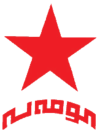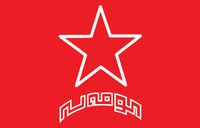Komala Party of Iranian Kurdistan
The Komala Party of Iranian Kurdistan (Kurdish: كۆمهڵهی شۆڕشگێڕی زهحمهتكێشانی كوردستانی ئێران, romanized: Komełey Şorrişgêrrî Zehmetkêşanî Kurdistanî Êran, lit. 'Society of Revolutionary Toilers of Iranian Kurdistan'), commonly shortened to Komalah (Kurdish: Komełe; Persian: کومله), is an armed communist[4][5][6] ethnic party of Kurds in Iran, currently exiled in northern Iraq.[2]
Komala | |
|---|---|
 | |
| Abbreviation | KŞZK |
| Leader | Abdullah Mohtadi[2] |
| Founded | Refounded in 2000 |
| Split from | Komalah (CPI) (2000) |
| Merged into | Communist Party of Iran (1984) |
| Headquarters | Sulaymaniyah, Kurdistan Region |
| Membership (2017) | <1,000 (estimate)[3] |
| Ideology | Communism Marxism–Leninism Historical: Maoism (1969–1979) |
| Political position | Far-left |
| National affiliation | Congress of Nationalities for a Federal Iran |
| International affiliation | Socialist International (Observer) Progressive Alliance UNPO |
| Colors | Red |
| Party flag | |
 | |
| Website | |
| Komala | |
| |
The group is currently proscribed as a terrorist organization by Japan, aside from Iran. Since 2018, it is a registered lobby in the United States.
Komalah has been engaged in guerrilla warfare against the Iranian government, notably during the 1979 Kurdish rebellion and the Iran–Iraq War. It was also involved in armed conflict against the Democratic Party of Iranian Kurdistan (KDPI) during the 1980s and early 1990s.[7] After a long time ceasefire, in 2017 the organization declared to have resumed armed conflict with Iran.[3]
The organization has "no strong influence among the Kurds in Iran", according to Rodi Hevian.[2]
History
It is not known when exactly the organization began its activity.[8] According to the account of Abdullah Mohtadi, together with six other Kurdish students in Tehran, he co-founded the group on 27 October 1969 at a secret initiation meeting.[9] This is disputed by Hussein Moradbegi and Iraj Farzad, two co-founders who state that the group was officially born on 26 January 1979. Abbas Vali argues the latter view is correct, as the 1969-established organization had no specific ethnic identity and had no position on Kurdistan, and Kurdish members of the former –Foad Mostafa Soltani, Mohammad Hossein Karimi, Abdollah Mohtadi, Tayeb Abbas Ruh Illahi, Mohsen Rahimi, Ibrahim Alizade, Sa’ed Vatandoust, Hussein Moradbagi, Omar Ilkhanizadeh and Iraj Farzad– created an offshoot.[10]
The organization initially operated underground, and went into public after the Iranian Revolution in 1979.[11] Shortly afterwards, they boycotted March 1979 referendum, as well as the next referendum of December 1979.[12] Ladislav Bittman wrote in The KGB and Soviet Disinformation that Komala was part of KGB's network in Iran, and was founded under financial and ideological influence of Soviet Union.[13] Edgar O'Ballance states that Komala received "help" from the Soviet KGB.[14]
In 1981, Komala refused to join the National Council of Resistance of Iran (NCRI).[15]
In September 1983, the group underwent organizational changes and patterned itself as an orthodox communist party, eventually joining Communist Party of Iran, as its Kurdish wing.[16] In 2000, the faction led by Abdullah Mohtadi split from the latter and styled itself as the "original" Komala.[17]
During George W. Bush administration, the group's leader met American officials in 2005 and 2006 amidst approval of Iran Freedom and Support Act budget. While it is unclear which groups have been funded through the program, Mohtadi welcomed an aid in 2008 and stated "If you’re a political movement that is part of an opposition, you need help from abroad... We're not ashamed to admit it."[18]
On grounds that politburo acts non-democratic, the faction led by Omar Ilkhanizade split in October 2007, founding the faction of reform.[19] On 29 April 2008, another faction led by Abdulla Konaposhi accused Mohtadi of "non-democratic management", and expressing dissatifcation to a policy of a cooperation with monarchists including Reza Pahlavi, split from the group to establish the reunification faction.[19]
Ideology
The group is ideologically Marxist–Leninist, therefore it saw itself revolutionary and transcending ethnic boundaries, unlike rival Democratic Party of Iranian Kurdistan.[16] It was predominantly Maoist during first decade of its activity[16] and adopted it as a mobilization strategy to recruit from peasantry and lower urban class.[20] Michael Gunter says that inspired by Chinese Communist Revolution, they became Maoists and viewed Kurdish nationalism as parochial.[21]
However at its first congress held in 1979, the ideology was renounced due to being "inappropriate to Kurdish conditions in Iran".[16] In 1981, the group initiated self-criticism of its past and concluded that what it needs is "strong links with the proletariat".[11]
Armed activities
.jpg)
Following Iran–Iraq War, the group were stationed inside Iraqi soil and were supported by Saddam Hussein and his Ba'athist regime,[22] who was willing to leverage insurgent groups against Tehran.[23] Saddam gave the group money, logistical support and arms.[24] After 1991, they found more secure sanctuaries under de facto autonomous Kurdistan Region.[23]
Headquarters of the group is currently located in an installation in Zergwez, about a 20-minute drive southeast of Sulaymaniya.[25] A European mission reported in 2012 that the camp has strict security measures at the entry gate.[25] Their previous camp was located in the vicinity of Halabja, near Iran–Iraq border, but after they suffered from attacks by Iranian Armed Forces, they moved to the current place.[25]
James Martin of The Jerusalem Post who visited the camp in 2007, wrote that Komala guerillas were equipped with AK-47s and RPGs, and are also trained in using anti-aircraft guns.[26]
A report published by Combating Terrorism Center in 2017, estimated that the group has less than 1,000 members.[3]
Designation as a terrorist organization
The following countries have listed Komola as a terrorist organization:
| Country | Ref |
|---|---|
| [3] | |
| [27] |
Lobbying activities
In September 2018, the group opened an office in Washington D.C., and formally registered as a lobby organization in the United States, while it was reported to hold meetings with Congressmen from both parties since at least 2015.[1] According to filed reports, Komala spent $7,500 in 2018 and in the next year, penned a $4,000 per month contract with the firm AF International, along with another worth $40,000 with Cogent Law Group.[28] One-fourth of latter included working on an op-ed, advise to establish a charitable foundation in the U.S., and "develop" Wikipedia page.[29]
See also
- Komala of Revolutionary Toilers of Iranian Kurdistan (1969/1979–1984)
- Komala Kurdistan's Organization of the Communist Party of Iran (1984–present)
- Komala Party of Iranian Kurdistan (2000–present)
- Komala of the Toilers of Kurdistan (2007–present)
- Komala Party of Iranian Kurdistan – Reunification Faction (2008–present)
- Socialist Faction of Komala (2009–present)
- Komala Party of Iranian Kurdistan (2000–present)
- Komala Kurdistan's Organization of the Communist Party of Iran (1984–present)
References
- Detsch, Jack (2 October 2018), "Kurdish rebels join anti-Iran lobbying fray", Al-Monitor, archived from the original on 2 October 2018, retrieved 30 March 2020
- Rodi Hevian (Summer 2013). "THE MAIN KURDISH POLITICAL PARTIES IN IRAN, IRAQ, SYRIA, AND TURKEY: A RESEARCH GUIDE". Middle East Review of International Affairs. Herzliya, Israel: Rubin Center for Research in International Affairs. 17 (2).
- Milburn, Franc (May 2017), "Iranian Kurdish Militias: Terrorist-Insurgents, Ethno Freedom Fighters, or Knights on the Regional Chessboard?", CTC Sentinel, Combating Terrorism Center, 10 (5): 1–2 – via Eidgenössische Technische Hochschule Zürich
- Kazemzadeh, Masoud (2009). "U.S.–Iran Confrontation in the Post-NIE World: An Analysis of Alternative Policy Options". Comparative Strategy. 28 (1): 14–27. doi:10.1080/01495930802679736. ISSN 1521-0448.
- Azeez, Govand Khalid (2019). "The "Kurd" between capitalist-statist nationalism and class conflict". Critique. 47 (3): 411–432. doi:10.1080/03017605.2019.1644724. ISSN 1748-8605.
- Akbarzadeh, Shahram; Shahab Ahmed, Zahid; Laoutides, Costas; Gourlay, William (2019). "The Kurds in Iran: balancing national and ethnic identity in a securitised environment". Third World Quarterly. 47 (3): 1–18. doi:10.1080/01436597.2019.1592671. ISSN 1360-2241.
- Hussein Tahiri (2007). The Structure of Kurdish Society and the Struggle for a Kurdish State. Bibliotheca Iranica: Kurdish studies series. 8. Mazda Publications. p. 144. ISBN 9781568591933.
- Ezzatyar, Ali (2016), The Last Mufti of Iranian Kurdistan: Ethnic and Religious Implications in the Greater Middle East, Springer, p. 35, ISBN 9781137563248
- Ezzatyar, Ali (2016), The Last Mufti of Iranian Kurdistan: Ethnic and Religious Implications in the Greater Middle East, Springer, p. 104, ISBN 9781137563248
- Vali, Abbas (2020), The Forgotten Years of Kurdish Nationalism in Iran, Springer, pp. 165–166, doi:10.1007/978-3-030-16069-2, ISBN 978-3-030-16069-2
- Kreyenbroek, Philip G.; Sperl, Stefan, eds. (2005). The Kurds: A Contemporary Overview. Routledge. p. 143. ISBN 9781134907663.
- Romano, David (2006). The Kurdish Nationalist Movement: Opportunity, Mobilization and Identity. Cambridge Middle East studies. 22. Cambridge University Press. p. 236. ISBN 978-0-521-85041-4. OCLC 61425259.
- Bittman, Ladislav (1983), The KGB and Soviet Disinformation: An Insider's View, Pergamon-Brassey's, p. 111, ISBN 9780080315720
- O'Ballance, Edgar (June 1981), "The Kurdish Factor in the Gulf War", Military Review: The Professional Journal of the United States Army, 61 (6): 16
- Hobday, Charles; East, Roger (1990). Bell, David Scott (ed.). Communist and Marxist parties of the world. Longman. p. 245. ISBN 9780582060388.
- Entessar, Nader (2010). Kurdish Politics in the Middle East. Lanham: Lexington Books. p. 49–50. ISBN 9780739140390. OCLC 430736528.
- Romano, David; Gurses, Mehmet (2014), Conflict, Democratization, and the Kurds in the Middle East: Turkey, Iran, Iraq, and Syria (1st ed.), Springer, p. 75, doi:10.1057/9781137409997_4, ISBN 978-1-137-40999-7
- Daragahi, Borzou (15 April 2008), "Iran says U.S. aids rebels at its borders", The Los Angeles Times, retrieved 11 May 2020
- Ahmadzadeh, Hashem; Stansfield, Gareth (2010), "The Political, Cultural, and Military Re-Awakening of the Kurdish Nationalist Movement in Iran", Middle East Journal, 64 (1): 11–27, JSTOR 20622980
- Romano, David (2006). The Kurdish Nationalist Movement: Opportunity, Mobilization and Identity. Cambridge Middle East studies, 22. Cambridge University Press. p. 233. ISBN 978-0-521-85041-4. OCLC 61425259.
- Gunter, Michael M. (2009). The A to Z of the Kurds. Scarecrow Press. p. 102. ISBN 9780810863347.
- Lolaki, Seyed Mohammad (2020). Diverging Approaches of Political Islamic Thought in Iran since the 1960s. Springer. p. 211. doi:10.1007/978-981-15-0478-5. ISBN 978-981-15-0478-5.
- Wenger, Andreas; Wilner, Alex, eds. (2012). "Deterring Kurdish Insurgent Attacks". Deterring Terrorism: Theory and Practice. Stanford University Press. p. 231–232. ISBN 9780804783477.
- van Bruinessen, Martin (1986). "The Kurds between Iran and Iraq". MERIP Middle East Report (141): 14–27. doi:10.2307/3011925. ISSN 0888-0328. JSTOR 3011925.
- "Report on Joint Finnish-Swiss Fact-Finding Mission to Amman and the Kurdish Regional Government (KRG) Area, May 10-22, 2011" (PDF), Finnish Immigration Service, Federal Office for Migration (Switzerland), 1 February 2012, 1170945 – via Austrian Centre for Country of Origin and Asylum Research and Documentation (ACCORD)
- Martin, James (23 August 2007), "Lunch with Komala", The Jerusalem Post, retrieved 15 April 2020
- "Komaleh,Kumele" コマラ (in Japanese). Ministry of Justice of Japan. Archived from the original on 9 March 2019. Retrieved 20 April 2020.
- Pecquet, Julian, ed. (11 September 2019), "Annual Overview 2019: Iran opposition buoyed by Trump's 'maximum pressure' campaign", Al-Monitor Lobbying Tracker, retrieved 30 March 2020
- Schaffer, Aaron (5 February 2020), "Iranian Kurdish rebels hire law firm to lobby Trump administration", Al-Monitor, archived from the original on 6 February 2020, retrieved 20 April 2020